- Home
- TV History
- Network Studios History
- Cameras
- Archives
- Viewseum
- About / Comments
Skip to content
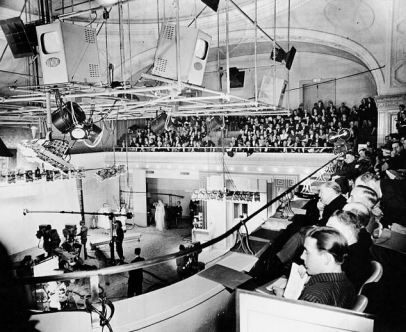





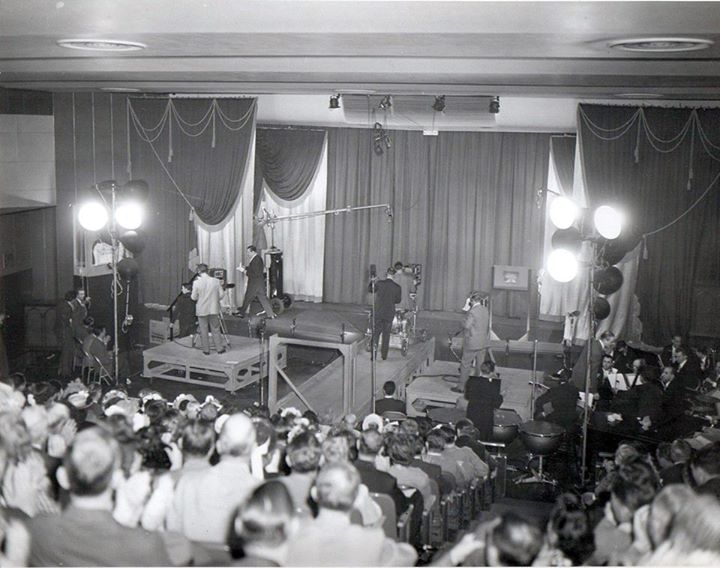

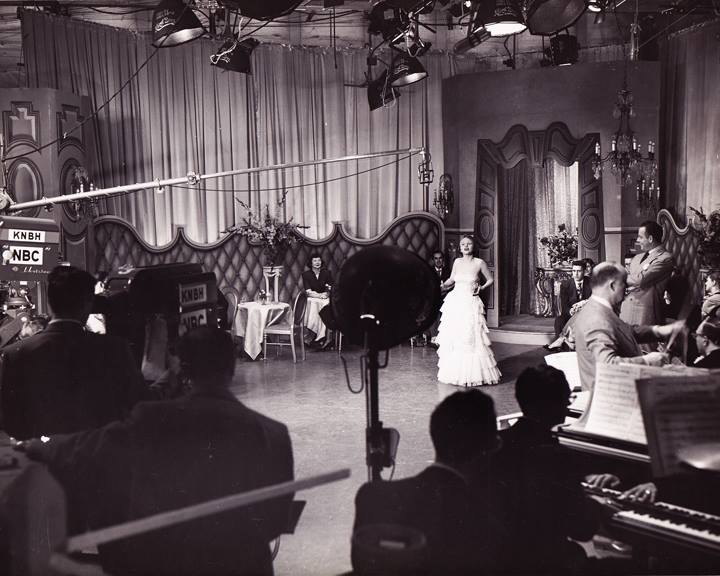

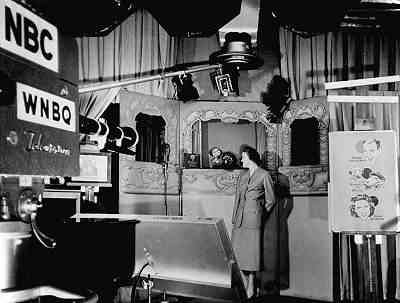



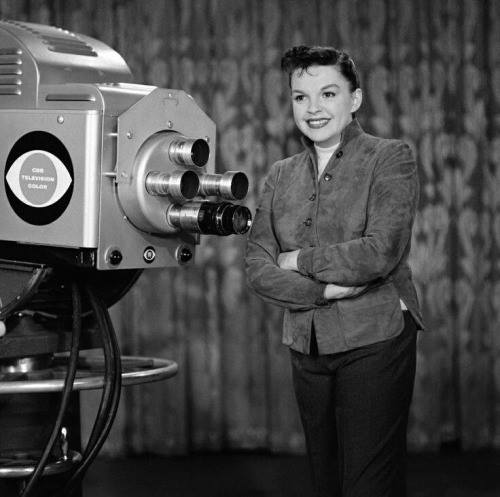



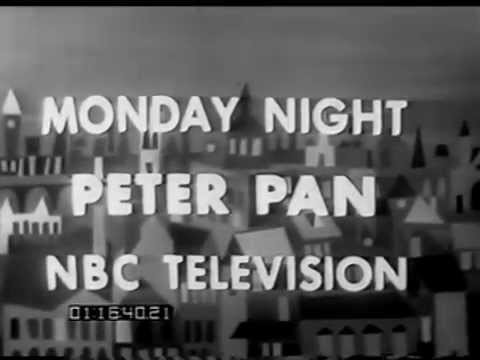



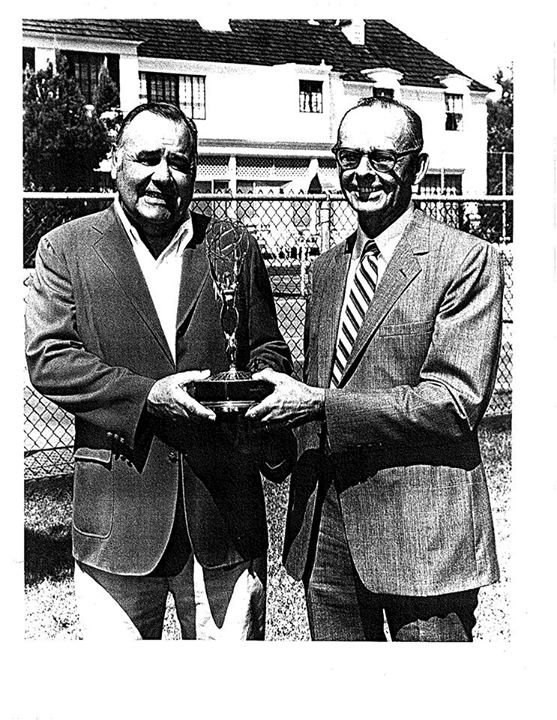

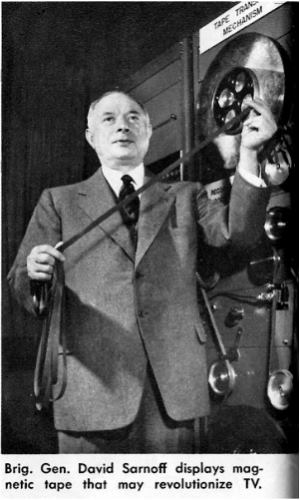
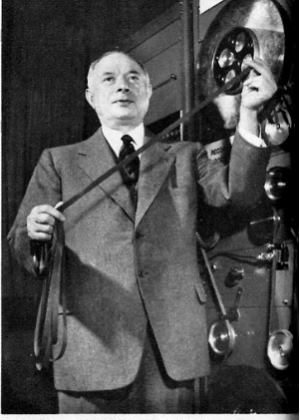


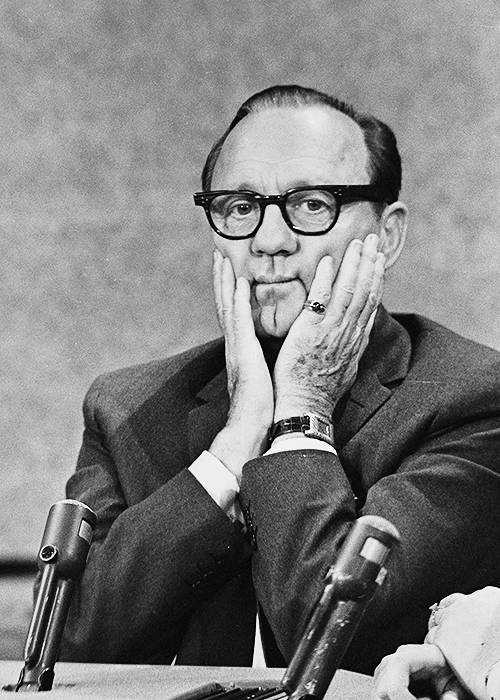
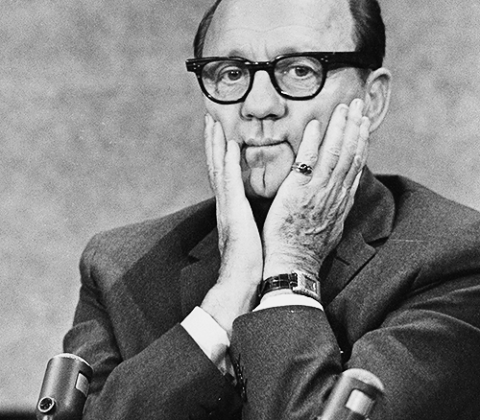
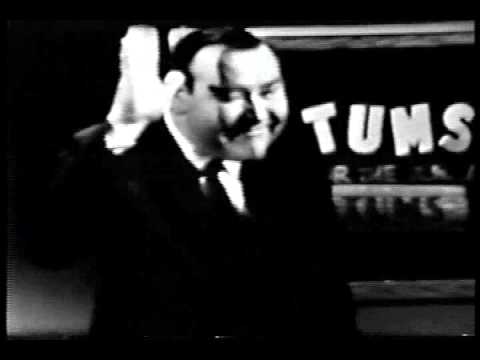

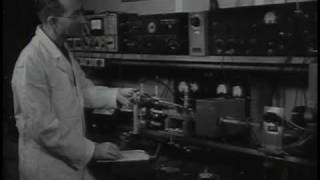



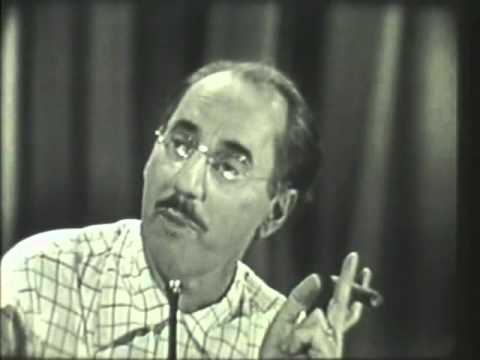

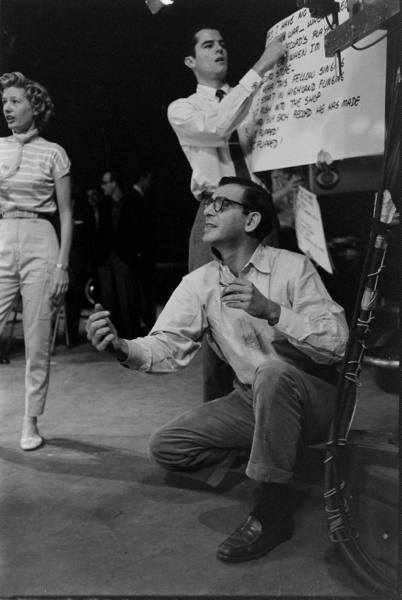

Search Results for: kinescope
April 15, 1946 & 1955…Big Days For Dumont, Gleason And Lewis
On April 15, 2016
- TV History
April 15, 1946 & 1955…Big Days For Dumont, Gleason And Lewis
This is a two part story, of two April 15th news making days for Dumont; one in 1946, the other in 1955.
Part 1, The Glory Days: This big photo was taken April 15, 1946 and shows the inaugural broadcast from the new Dumont studio at Wanamaker’s department store in Manhattan. The telecast was fed to Dumont’s W3XWT (WTTG) in Washington for broadcast there, and in Washington, some FCC officials making congratulatory comments were fed back to New York and viewed by the audience here.
Before this, Dumont’s limited local broadcasts on it’s WABD, had come from a small experimental studio at their 515 Madison Avenue headquarters,
Part 2, A Dying Breath Brought New Life To Video Assist: In the very last days in operation as a network, Dumont introduced the Electronicam.
By late ’54 the handwriting was on the wall…in February of 1955, Dumont executives realized the company could not continue as a television network. It was decided to shut down network operations and operate WABD and WTTG as independents. On April 1, 1955, most of DuMont’s entertainment programs were dropped.
April 15, 1955, nine years to the day after opening their studio at Wanamaker’s Department Store, the company introduced the 35 and 16mm versions of the Dumont Electronicam. The hope was that this new video and film production tool would help save the company, and after all, the end result was much better than the kinescope.
In September of ’55, Jackie Gleason began production of the new half hour “The Honeymooners” show for CBS. It was shot at Dumont’s Adelphi Theatre on 54th Street, with three 35mm Electornicams.
On a visit with Gleason at The Adelphi in 1956, Jerry Lewis saw the Electronicam, and never forgot that.
’56 was the year he and Dean Martin split, and Lewis did a few solo movies for director Hal Wallis, but became involved in the production as well.
By ’60, Lewis was on his own and began writing, directing and starring in his own movies with Paramount as a partner. All the while the Electronicam process was on his mind, and by the early 60s, he had begun the process of developing a true video assist technology.
By ’66, he had created “Jerry’s Noisy Toy” which included instant video and audio tape playback capacity using an RCA vidicon cameras interlinked with Mitchell BNC cameras, and one inch Sony videotape. -Bobby Ellerbee
The History Of Video Tape Development By The Man Who Did It!
On April 12, 2016
- Archives, TV History
Melvin Sater’s 18 page account of those early days of developing the first commercially available line of video tape, at 3M.
Above is Melvin Sater’s 18 page account of those early days of developing the first commercially available line of video tape, at 3M. Most of this amazing read has to do with the 1956 and ’57 period, but also takes us into the mid ’60s and color tape. (Above, Sater with Jonathan Winters and the EMMY Sater won).
Those first rolls of 3M tape used for the April ’56 NAB demonstration could only give 15 to 25 playbacks, but in order to switch from kinescopes to videotape that next summer, the networks needed something that would give them at least 65 to 100 playbacks.
By the April 12, 1957 CBS tests, they were elated that they were able to get up to 390 replays before the tape broke down, but there were more hurdles to overcome. The 3M plant was working literally around the clock to produce enough tape for the summer of ’57 introduction, but 97% of the initial runs had to be scrapped and the manufacturing process modified.
By the way…they were flying blind on this! Ampex had not been able to get them a VTR to use in testing, so this was all theory and trial and error.
The top photo of Mel Sater and Johnathan Winters, show him with the EMMY that was presented to Sater for his work in videotape development, and Johnathan was a part of that.
The first use of videotape in a network show was a three minute black and white insert into “The Johnathan Winters Show” by NBC in 1957. The prerecorded song by Dorothy Collins was inserted without fanfare to see if the viewing audience would notice it. They didn’t.
History buffs will want to save this link and share it with their friends as this is the only place to find this on the web. Our thanks again to Neil Gjere for sharing this. -Bobby Ellerbee
TeleTales #67…The Art Of Shooting Live Drama
On February 9, 2015
- TV History
TeleTales #67…The Art Of Shooting Live Drama
Before videotape, there were only kinescopes, so shows had to be done live. Just take a moment and study the photo below from Television City…that’s tight in every way. The floor camera is shooting the actor on top (Edmond O’Brien), the crane is shooting the other, the boom is there for sound and there’s even a hand held face light.
This takes choreography…a well laid plan and skilled crew. John Frankenheimer was one of the best ever live directors and did many of these shows. If you never have, take a look at “The Comedian” at the link below. Frankenheimer directed this “Playhouse 90” presentation that takes places behind the scenes at Television City…TK11s are everywhere. Enjoy and share! -Bobby Ellerbee
TeleTales # 51…NEW, ULTRA RARE! “Texaco Star Theater”
On February 4, 2015
- TV History
TeleTales # 51…NEW, ULTRA RARE! “Texaco Star Theater”
This is just amazing! I have studied this very closely and believe this to be, if not the debut show, at least a photo taken in the first month of “The Texaco Star Theater” starring Milton Berle. This is the ONLY behind the scenes photo I have every seen of this show in production.
This was taken in NBC Studio 6B that was converted from radio to television on June 8, 1948, just in time for the debut of Berle’s show. I have several pictures of this studio in late ’48 in which the camera platforms have back rails, but notice there are none here yet which makes them brand new and this is possibly their first use.
Also notice the title card on the right side of the stage. As you can see at the start of this earliest video of the show, it is the same.
At the time this was taken, only NBC Studios 3H and 8G had their own cameras. Television was being done in what were then radio studios 3A, 3B, 6A and 6B with several in house mobile units with three cameras each. The Camera Control Units were on wheels and were placed in the sound locks of the studio.
When I mention the dates the studios were converted from radio to television, that means the date that these studios finally got their own control rooms. Even before the June 8, 1948 debut of 6B, some television was done here with the mobile units, which was also the case for 3A, 3B and 6A. In September of 1949, these mobile units would also finally enter Studio 8H for the television debut of “The Voice Of Firestone”. Many thanks to Mike Clark for sharing this, AND some great pictures yet to be posted! Enjoy and SHARE! -Bobby Ellerbee
January 16, 1949…KNBH Television Signs On; Exclusive Photos
On January 16, 2015
- TV History
January 16, 1949…KNBH Television Signs On; Exclusive Photos
These two black and white photos are the only ones I know of that were taken on that first day of broadcasting.
The young lady in both is Peggy Lee, who I think was the mistress of ceremonies that night for the stations first live show, and first local variety program in Los Angeles called ‘On With The Show’.
At the time, she, along with Perry Como and Jo Stafford were rotating host of NBC Radio’s popular ‘Chesterfield Supper Club’.
The maiden broadcast was three hours and forty minutes of programming, which followed a 15-minute test-pattern-and-music session. Inauguration night launched with an eighteen-minute newsreel, ‘Review of 1948’. That was followed by the first live program, hosted by Lee. After that came ‘The Pickard Family’ featuring Dad and Mom Pickard and their four children singing familiar American songs.
The station now known as KNBC or NBC4, was one of seven VHF stations licensed for operation in the market. KNBH, which stood for National Broadcasting Hollywood, was one of three stations in the market representing a national broadcasting chain.
By October 1949, KNBH had extended its operating schedule from five to seven days a week, with approximately 26 hours of television programming each week. The station continued to make major technical advances and was the leading promoter of television as the premiere advertising medium. In October 1950, KNBH transmitted the first commercial telecast of a sports event, a Los Angeles Rams Football Game, via the Los Angeles/San Francisco inter-city MicroWave Relay.
KNBH again made history in April 1951 when the first telecast, originating in the East, was presented to West Coast viewers on the same day. The station broadcast General Douglas MacArthur’s speech before Congress less than five hours after it had been originated in Washington, D.C. I think this was achieved by recording a kinescope in St. Louis and flying it to LA.
In November 1962, the station relocated to the NBC Burbank facilities, and changed its call letters to KNBC.
When the station launched in 1949, Los Angeles was the fifth largest city in the United States, with only 80,000 television sets within 100 miles of the station’s Mount Wilson transmitter. Today, the LA market is the second largest in the country and Channel 4 is viewed in more than five million households, reaching 15 million viewers regularly.
Happy Birthday KNBC! Enjoy and share! -Bobby Ellerbee
January 12, 1949…’Kukla Fran And Ollie’ Debuts On NBC Network
On January 12, 2015
- TV History
January 12, 1949…’Kukla Fran And Ollie’ Debuts On NBC Network
Before we get to the history, a comment on this rare kinescope.
In the clip, we see Dave Garroway visiting with KFO just before their trip to RCA’s Wardman Park Hotel experimental color studio, where on October 10, 1949 they did a special closed circuit colorcast for the FCC. Later that same day, they did the regularly schedulded black and white network show from NBC’s WRC studios.
KFO actually started on Chicago’s WBKB around 1948, but moved to NBC owned WNBQ later in 48 and was a huge Chicagoland hit. The NBC network heard about it and decided to air it afternoons nation wide and the first network broadcast, live from Chicago, was on this day in 1949.
By the way, the laughter in the clip is form the crew and the seven member band which was just to the left of the set and hidden by the RCA TK30. FYI, when the show was at WBKB, they were the ones that began shooting it with the Zoomar Field Lens…it looked so good, NBC continued with it. Oh…one more thing…at the time, Garroway was hosing ‘Garroway At Large’ which was a popular Chicago show. January 14, 1952, he began hosting ‘Today’ when it debuted on NBC from New York. Enjoy and share! -Bobby Ellerbee
The First Color Tape Production, 1958
On January 4, 2015
- TV History
Above is a photo of Fred Astaire and dancer Barrie Chase in dress rehearsal for ‘An Evening With Fred Astaire’ at NBC Burbank on October 17, 1958. Further below is a link to the whole show.
The show was broadcast live in the east, but was recorded on color video tape for playback to the west…this was a first! The year before, CBS had done the same with ‘The Edsel Show’, but that was a black and white videotape performance.
As mentioned in today’s earlier story on the ‘Ford Star Jubilee’, CBS and NBC could broadcast live color from Los Angeles to the east cost, but until now, the west coast playbacks were always via black and white kinescopes. This is one reason that color production in the west, as well as color set sales always lagged the east coast. Enjoy and share! -Bobby Ellerbee
First CBS Color Special, ‘Ford Star Jubilee’ 1955
On January 4, 2015
- TV History
Picture Parade #2…First CBS Color Special, ‘Ford Star Jubilee’ 1955
Information is hard to come by, but it is thought that for CBS, this was their first full scale color broadcast using the RCA/NTSC Dot Sequential color system. The show came from CBS Television City’s Studio 43.
The event on September 24, 1955 was a double debut of sorts. It was the debut of ‘The Ford Star Jubilee’ anthology series, but was also called ‘The Judy Garland Special’, as she was the star. This show was telecast live in color from Los Angeles, but only the East Coast saw it in color. Other time zones saw a black and white kinescope, most of which survives today. Here is a clip of the whole one hour special but is it qued up to Judy singing “Somewhere Over The Rainbow” from the show. Enjoy and share! -Bobby Ellerbee
By the way, this was the first TV special to have what amounted to a “soundtrack album”, since most of the songs on the Capitol recording “Miss Show Business”, released two days after the broadcast, were what Judy had sung on this special.


December 28, 1956…The Last ‘Ding Dong School’ Airs On NBC
On December 28, 2014
- TV History
December 28, 1956…The Last ‘Ding Dong School’ Airs On NBC
‘Ding Dong School’ was developed by NBC’s Chicago station WNBQ and was first broadcast November 24, 1952. The show quickly gained popularity among young children and soon, was broadcast nationally on the NBC network, Monday through Friday. In that year, Dr. Frances Horwich, the shows host and creator, won a Peabody Award. The series is said to have garnered a 95 percent share of all preschoolers at one time. I was one of them…you too?
In 1954, NBC moved the show to New York where “Miss Francis” was put in charge all of NBC’s children’s programming. She held this position until 1956, when ‘Ding Dong School’ was canceled. Horwich owned the rights to Ding Dong School and syndicated the show until 1965.
Before starting the show, Dr. Horwich had earned her master’s degree in education at Columbia University and her doctorate at Northwestern University, and was the head of the department of education at Chicago’s Roosevelt College. She is cited as having invented the television technique of speaking to the children watching as if they were in the same room across from you. Those who subsequently adopted this style included Fred Rogers, ‘Romper Room’ and ‘Sesame Street’. Enjoy and share! -Bobby Ellerbee


ULTRA RARE! 1956 ‘Peter Pan’ Promo
On December 2, 2014
- TV History, Viewseum
ULTRA RARE! 1956 ‘Peter Pan’ Promo
As we just read in this morning’s first story, the first television production of ‘Peter Pan’ was March 7, 1955. On January 9, 1956, NBC Brooklyn did it again…live and in color. Here is a promo for the second broadcast that fortunately was captured from inside a kinescope of the January 6, 1956 ‘Ernie Kovacs Show’. Thanks to Ben Model for the capture and to Randy West for bringing this to my attention. Enjoy and share! -Bobby Ellerbee
This is the promo that aired on NBC in January 1956 for “Peter Pan” starring Mary Martin. Sourced from a kinescope of “The Ernie Kovacs Show” from Jan 6, 1956
November 30, 1956…First Videotape Delayed Broadcast, CBS Television City
On November 30, 2014
- TV History
November 30, 1956…First Videotape Delayed Broadcast, CBS Television City
CBS made broadcast history when they replayed ‘The Evening News With Douglas Edwards’ to the west coast. After recording the live feed coming down the network line from New York at 4 p.m. Pacific time, the program was played back three hours later.
In the large photo, we see CBS Engineer John Radis at the Ampex VRX-1000 playing back the show. On the phone to his right is Jim Morrison who is probably on the phone to the control room. I think a kinescope of the newscast was rolled simultaneously just in case there were problems with the tape playback.
This VRX-1000 is one of only 16 hand-built machines Ampex rushed to produce after debuting the VTR eight months before. The two racks of tube equipment to the left contain the electronics for the recorder.
Also pictured here is one of the first photos of the new CBS videotape room at Television City which was kept busy recording network feeds for time-zone delay and eventually, programs produced in the studios at Television City.
It would take over a year for CBS New York to get videotape machines due to a huge backlog, even though the networks got priority. In early 1958, 14 VR 1000 went into service as CBS Grand Central. NBC too had the bulk of their machines on the west coast but both CBS and NBC had two VTRs in New York which were mostly used for testing and engineering purposes.
In the color photo, we see the historic Douglas Edwards machine being retired in 1978. Early on, it had been fitted with RCA color modules as Ampex and RCA traded technology rights. RCA had developed color recording in 1954 and allowed Ampex to use it if they would allow RCA to use the Qaud recording head.
The final photo shows one of two Ampex VRX 1000s used at the first public demonstration at the NARTB convention in Chicago in April of ’56. In today’s next story…the history of the first instant playback. Enjoy and share! -Bobby Ellerbee
The History Of 3M Video Tape Development By The Man Who Did It!
On November 19, 2014
- TV History
The History Of Video Tape Development By The Man Who Did It!
Above is Melvin Sater’s 18 page account of those early days of developing the first commercially available line of video tape. Most of this amazing read has to do with the 1956 and ’57 period, but takes us into the mid ’60s and color tape.
Those first rolls used for the April ’56 NAB demonstration could only give 15 to 25 playbacks, but in order to switch from kinescopes to videotape that next summer, the networks needed something that would give them at least 65 to 100 playbacks.
The photo of the piece of tape from the April 12, 1957 CBS tests we saw yesterday is explained here and they were elated that they were able to get up to 390 replays before the tape broke down, but there were more hurdles to overcome. The 3M plant was working literally around the clock to produce enough tape for the summer of ’57 introduction, but 97% of the initial runs had to be scrapped and the manufacturing process modified.
By the way…they were flying blind on this! Ampex had not been able to get them a VTR to use in testing, so this was all theory and trial and error. History buffs will want to save this link and share it with their friends as this is the only place to find this on the web. Our thanks again to Neil Gjere for sharing this. Up next is Neil’s backstory of how he met Mel Sater’s son and was able to gather all this rare history, the iconic relics and rare photos. Enjoy and Share! -Bobby Ellerbee
Below is a photo of Mel Sater and Johnathan Winters. The EMMY was presented to Sater for his work in videotape development. The first use of videotape in a network show was a three minute black and white insert into ‘The Johnathan Winters Show’ by NBC in 1957. The prerecorded song by Dorothy Collins was inserted without fanfare to see if the viewing audience would notice it. They didn’t.


A FANTASTIC HISTORY OF AUDIO AND VIDEO TAPE!
On November 11, 2014
- Archives, TV History
This is a must read for anyone interested in the early days of audio and video recording! While researching today’s story on the first demonstration of videotape, I happened to find this gem…it’s from The American Heritage series on Invention and Technology.
This seven page article is as good as it gets and is more detailed than anything on the subject that I have seen anywhere! Bookmark, read, save and SHARE this! Enjoy! -Bobby Ellerbee
The Race To Video
1954; The Year In Color At NBC
On November 2, 2014
- TV History
On A Related Note…1954; The Year In Color At NBC
Just a month before NBC Brooklyn Studio I went live in September of 1954, the NBC Color Caravan wrapped up a three month sojourn through the midwest and mid Atlantic states, but that was just a small part of a year brimming with color at NBC and RCA. Here are the highlights of that industrious year.
January 1, 1954: ‘The Tournament of Roses Parade’, from Pasadena was telecast in color by twenty-one stations of NBC’s first coast-to-coast color network. This colorcast also marked the first use of NBC’s new mobile color TV unit and the first West-to-East transcontinental transmission of color television.
February 16, 1954: NBC transmitted the first newscast in color… ‘The Camel News Caravan’, including the first integration of 16-mm color film into a live program.
March 4, 1954: The first shipment of RCA TK40s, and associated studio equipment was made from RCA’s plant in Camden, N.J. This was after two years of testing of the TK40 prototypes at NBC’s Colonial Theater.
March 19, 1954: The first colorcast of a boxing match from Madison Square Garden, was presented by NBC and was their first color sports event.
March 25, 1954: Production of RCA’s first commercial color TV sets, the CT 100s, equipped with a 15-inch picture tube began at Bloomington, Indiana.
June 25, 1954: NBC made the first network transmission of 35-mm color film, on ‘The Mrs. USA’ program.
July 8 – Aug. 19: NBC aired the first network color series, ‘The Marriage’, a situation comedy with Jessica Tandy and Hume Cronyn.
July 15, 1954: RCA announced development of a new and improved 21-inch color kinescope with a picture area of 255 square inches.
September 12, 1954: NBC presented the first of its 90 minute color spectacular, ‘Satins and Spurs’. The program also inaugurated NBC’s new Brooklyn Studio I.
September 15, 1954: RCA demonstrated its new 21-inch color picture tube and a simplified color TV receiver.
Oct. 14 – Dec. 30: ‘The Ford Theatre’ was the first network sponsored TV color film series to be presented on a regular basis.
November 28,1954: First two-hour color production of a Shakespeare play, “Macbeth” on ‘Hallmark Hall of Fame’.
December 1, 1954: RCA began commercial production of color TV sets with a new 21-inch picture tube.
Presented with thanks to Ed Reitan and Novia.net for the detials and all his many contributions to the perservation of television history and his archival efforts, which are many. Enjoy and share! -Bobby Ellerbee


October 28, 1950…’The Jack Benny Show’ Debuts On CBS
On October 28, 2014
- TV History, Viewseum
October 28, 1950…’The Jack Benny Show’ Debuts On CBS
The video here is a kinescope of that first show, with special guest Dinah Shore. Since Television City was still being built, this probably originated at the CBS Studios at 1313 Vine Street or from Studio A at Columbia Square.
On this debut show which includes singer Snooky Lansen selling cigarettes at the start and Mel Blanc’s debut as a guest on the show (9:15), as Mel plays a stage hand. The monologue and the sketch are about how Jack decided to go on television, and how he put his initial show together. Rochester sings “My Blue Heaven” while doing his housework. Mr. Kitzel drops by to wish Jack good luck. Dinah Shore sings “I’m Yours” over the phone to see if Jack approves of it for her guest spot. On the show, Ken Murray drops by to wish Jack good luck, and Dinah and Jack sing a duet: “I Oughta Know More About You”. The Sportsmen Quartet do the Lucky Strike commercial. Jack closes the program playing his signature song “”Love in Bloom” on the violin.
The regular and continuing ‘Jack Benny Show’ was telecast on CBS from October 28, 1950, to September 15, 1964, and on NBC from September 25, 1964, to September 10, 1965 with 343 episodes produced.
The television show was a seamless continuation of Benny’s radio program with many of the same players, the same approach to situation comedy and some of the same scripts.
The show appeared infrequently during its first two years on CBS as Benny moved into television slowly. In his first season (1950–1951), he only performed on four shows, but by the 1951-1952 season, he was ready to do one show approximately every six weeks. In the third season (1952–1953), the show was broadcast every four weeks. During the 1953-1954 season, Benny aired every three weeks. From 1954 to 1960, the program aired every other week, rotating with such shows as ‘Private Secretary’ and ‘Bachelor Father’.
Beginning in the 1960-1961 season, ‘The Jack Benny Show’ began airing every week. During the 1953-54 season, a handful of episodes were filmed at Desilu during the summer and the others were live, which allowed Benny to continue doing his radio show. Enjoy and share! -Bobby Ellerbee
October 23, 1956…Videotape Makes Its Network Debut On NBC
On October 23, 2014
- TV History
October 23, 1956…Videotape Makes Its Network Debut On NBC
58 years ago today, a two and a half minute video taped song from ‘Your Hit Parade’ star Dorothy Collins was inserted into ‘The Jonathan Winters Show’. NBC engineers in New York wanted to see if the viewing public could tell the difference from the live portion of the show. When no one noticed the transition, the age of video tape was born.
Details are a bit murky here, but I think this was all black and white and remember, this is only six months after Ampex introduced videotape at the 1956 NAB in April. Part of the confusion comes from the fact that Winters himself tells us that his 15 minute show was the first regular color series on television, but I think that may have happened in 1957. The first color videotaped specials were from ’57 as well and I think it took a year for RCA who had a color recording technology to work out the share with Ampex who had the quad head technology.
As for what the west coast saw, well…that would have been a kinescope of this show as the first ever tape delayed broadcast was November 30, 1956 at CBS with a broadcast of ‘Douglas Edwards With The News’. Unfortunately, there is no kinescope or tape of this historic event and all that’s available from Jonathan’s 1956 show is this :30 second intro. Enjoy and share! -Bobby Ellerbee
https://www.youtube.com/watch?v=m2nkN9HklrY
His first of two variety series. This one sponsored by TUMS. In the late 60s he tried again on CBS.


Television In The Army…1953 ‘The Big Picture’ Special
On October 22, 2014
- TV History, Viewseum
Television In The Army…1953 ‘The Big Picture’ Special
This is about as good a look at RCA TK 11/31s in action as you will ever get, but we also see Dumont 5098C cameras here. There are some RCA TK30s scattered in and even a small Dage portable and RCA’s Walky Looky. There’s a lot of camera footage here, but you’ll have to skip around some.
The first 10 minutes of this is done at the Army’s New York facility and is RCA heavy. Some of the TK30 footage of the war games was shot at West Point.
The second segment takes us to Augusta, Georgia and the Southeast Signal Corps School at Ft. Gordon (where I trained), and this installation was equipped with Dumont equipment, including a kinescope machine which we’ll see.
At around 14 minutes in, we see a small Dage portable and at 21, more of the mobile unit with TK30s. At 22:25 we see the RCA Walky Looky in action. Many of us that grew up in the 50s and 60s remember watching these ‘Big Picture’ presentations on our local stations. Do you remember? Enjoy and share! -Bobby Ellerbee

October 17, 1958…Video Tape Editing Makes It’s Debut!
On October 19, 2014
- TV History
October 17, 1958…Video Tape Editing Makes It’s Debut!
All week, we have danced around this subject with the Smith Block posts, but it was only this morning that I realized that we are at the 56th Anniversary of video tape editing. The following is excerpted from Richard Wirth’s article from March, which is included in full below.
The first official broadcast use of the Editor Synch Guide (ESG) system aired on October 17th, 1958, on the NBC special ‘An Evening With Fred Astaire’. It was also one of the first programs to be recorded on color videotape.
Video tape was introduced in late 1956 and as the 50’s wore on, more shows began to record in advance, but they had to be done live – recorded in their entirety in one pass. There was no way to stop and fix mistakes. It didn’t take engineers long to begin experimenting with ways to edit the unwieldy and unforgiving two-inch wide quadruplex recordings. Audiotape had been physically edited for years using a metal guide, a razor blade and some special adhesive tape. But television signals were more complicated, particularly in the way they were recorded on the tape.
NBC Burbank engineers and editors decided they had to come up with some kind of process to edit, and eventually they did. Kinescope equipment was still in use and available so they developed a system of editing using 16mm kinescope films. After a master videotape was recorded, a 16mm film “work print” would be made of it along with 16mm magnetic sound recordings. On the cue track of the master videotape, the sound area of the kinescoped film and the cue track of the 16mm sound recording engineers would record the Editor Sync Guide (ESG), a forerunner to what we know now as Time Code.
ESG consisted of a male voice calling out the minutes and a female voice calling out the seconds. Every 24 frames, there would be a one frame “beep” tone. Art Schneider, an NBC editor involved with the system’s creation, says in his book “Jump Cut” it took three people and a week to create the seventy-three minute ESG master recording.
The kine program would then be edited with frame accuracy using standard motion picture editing techniques. When complete, the tape was “conformed” to match the 16mm sound cue track. By the time the ESG was put into use, the manual videotape splicer had become more sophisticated to include adjustment dials and a microscope to ensure accuracy. Using the Smith Block, this became known as double system or offline editing.
Because of the twenty frame difference between the location of the video heads and the audio heads on the videotape machines, the 16mm sound track was used for all subsequent sound mixing and sweetening to maintain sync. After final mixing, it was laid back to the videotape in one pass.
The word of mouth buzz from Astaire program “literally opened up the floodgates to producers and directors who wanted their shows edited at NBC.” Word of its accuracy spread quickly and for about 10 years after, NBC Color City was place to go to edit your videotaped program! The editing on the Astaire program was minimal by comparison to some of the later efforts using the ESG system.
The ESG system was eventually used on ‘Rowan and Martin’s Laugh-In’…this was the first program use very quick cutting, sometimes just a few frames. For some segments, every camera take was a physical cut in the tape. It was said when the ‘Laugh-In’ master tapes were played, they had so many physical cuts they sounded like a machine gun firing as the tape passed the spinning video heads!
Many thanks to Richard Wirth for his fine work over the years. The full article, complete with videos is at this link. Enjoy and share! -Bobby Ellerbee
http://provideocoalition.com/pvcexclusive/story/the-demise-of-nbc-burbank-part-2
Recently, I wrote about the beginnings of NBC’s historic lot in Burbank as the Peacock network completed its move to nearby Universal Studios. The look back on NBC Burbank’s sixty-two year history wouldn’t be complete without exploring some of the technical history NBC engine…


October 5, 1950…’You Bet Your Life’ Debuts On NBC + Special Insights
On October 6, 2014
- TV History
October 5, 1950…’You Bet Your Life’ Debuts On NBC + Special Insights
We’re a day late with this, but it was on purpose as this pilot was directed by none other than Ralph Levy, who we just met in the article before this.
This the unaired pilot to the show that was kinescoped around the first of August in 1950 at CBS Columbia Square. Notice it is almost an hour long, yet the radio and TV show were only half hour shows. This is because Marx did so much ad libbing in trying to get contestants to say the “secret word” that each show had to be edited down on audio tape for the radio show and on film for the television show.
Unlike the NBC television show which was on film, this was shot with RCA TK30 television cameras as the radio show was recorded for editing and delayed broadcast, which explains the casual dress for Groucho.
Notice a few things. At the start, we have about 1:45 seconds of video before the start of the radio show. As we go, there are several times we do pickups of intros and extros. and at 51:35, Groucho pitches to Myron Wallace who we all now know as Mike Wallace. The pitch to Wallace was a blank space into which and Elgin Watch radio spot would be added as Wallace had been their spokesman beginning when this show was on ABC radio in 1947.
Director Ralph Levy…A CBS Superstar
On October 6, 2014
- TV History
Director Ralph Levy…A CBS Superstar
You may not know the name, but you know his work. Among other things, Ralph Levy directed the ‘I Love Lucy’ pilot, ‘The Jack Benny Show’, ‘Burns And Allen’ and as we just learned in today’s first article, ‘The Ed Wynn Show’.
A few months back, I posted a story on the vaudeville and radio stars Ole Olsen and Chic Johnson. They were most famous for their hit broadway show and movie called ‘Hellzapoppin’. As it turns out, CBS had tried to bring Olsen and Johnson to television in early 1949 and Ralph Levy was the assistant director. The show turned out to literally be too big for television because Olson and Johnson’s style was to have action not only play out on stage, but going on in the theater at the same time and often overlapping. The show ended after 13 weeks, but immediately after that, Levy was given a show of his own. It was a summer replacement called ‘The 54th Street Revue’ and came from CBS Studio 52 on 54th and Broadway.
Ralph managed to get the first of the shows on the air in only 4 days… an accomplishment that earned him both management’s attention and a reputation for working swiftly and efficiently. That fall, the network asked Levy to move to Los Angeles to direct a new variety series starring radio comedian Ed Wynn. If network TV in New York was just beginning, in Los Angeles it was virtually non-existent…
The Ed Wynn Show, Levy soon discovered, would be the first major network show to originate from Hollywood. It would be shown live on the West Coast every Thursday night at 9PM. A kinescope recording of the show would be made, sent to New York, and played for East Coast and Midwestern stations two weeks later. Such delays were necessary because the transcontinental cable was not yet in place that would allow for national live telecasts to originate on the West Coast.
In late December, Ed’s guests were Lucille Ball and Desi Arnaz and this was the first time Ralph met them. The script that night went out of its way to spotlight 32-year-old Desi, who appeared with Wynn and Ball in a comedy sketch, and even afforded him the opportunity to sing “Babalu.”
A few weeks later, CBS asked Lucy to consider transferring her radio series, ‘My Favorite Husband’, to TV. Levy, meanwhile, had come to be the network’s fair-haired boy in Hollywood…in April, he expanded his duties to include directing the new ‘Alan Young Show’, a weekly half-hour comedy-variety skein starring the young Canadian who today is more remembered for his role ten years later in the sitcom ‘Mr. Ed’.
One of the most successful programs on CBS Radio that season was ‘You Bet Your Life’, starring Groucho Marx. The show’s sponsor was interested in adding a TV version…both CBS and NBC wanted to carry it. When both major networks became interested, a bidding war started. Since Marx was already at CBS, it seemed likely he would stay, but Levy helped with a pilot show. When the dust settled, NBC was the high bidder, but Levy stayed at CBS.
The Ed Wynn Show ended its nine-month run on July 4, 1950, and Ralph headed to Mexico for a much-needed vacation. He had hardly unpacked when an emergency call came from CBS’ Hollywood operations. Levy was asked to come back the next day as George Burns and Gracie Allen had agreed to go on television, and CBS wanted him at the first production meeting.
A pilot was prepared and quickly sold to Carnation Milk Company and ‘The Burns & Allen Show’ was scheduled for a fall premiere. George was afraid to take on a weekly show all at once, particularly one that was to be done live, so CBS agreed to air it on an alternate-week basis.
Making his life even more interesting was the fact that George Burns’ best friend, Jack Benny, was toying with the idea of getting into television himself. Naturally, he wanted Ralph to direct. But Benny was even more shy about TV than George and Gracie, and agreed to do only four half-hour specials that first 1950-51 season.
Lucy and Desi Arnaz, meanwhile, spent the summer of 1950 performing a comedy act in vaudeville theatres across the country, and by late fall had convinced CBS to let them try a new TV series together. Lucy’s radio writers, Jess Oppenheimer, Bob Carroll Jr., and Madelyn Pugh went to work to create the format. Ralph Levy was asked to direct.
The pilot was filmed on Friday evening, March 2, 1951 (Desi’s 34th birthday) in Studio A of CBS’ Columbia Square headquarters in Hollywood. It was the same stage used for the Wynn Show a year earlier. The show was shot live with a studio audience in attendance, as most TV shows were being done then. There was no tape yet. The images were recorded on film from a TV screen, providing us with the required kinescope.Levy, CBS’s first choice to direct, begged off: he knew he already had his hands full.
In 1953, Ralph retired from ‘Burns & Allen’, and with ‘The Alan Young Show’ ceasing production, he concentrated his energies on the now bi-weekly Jack Benny program. He remained at Benny’s side another four seasons, then returned in 1959 to helm two hour long Benny specials. For these shows, he won his first Emmy Award. Ralph won a second Emmy two years later for first ‘Bob Newhart Show’, a weekly half-hour of stand-up comedy and variety.
When filmed sitcoms became the order of the day, Levy adapted: he directed the pilots of ‘The Beverly Hillbillies’ and ‘Green Acres’, and two seasons of ‘Petticoat Junction’, all for his friend Paul Henning, one of George Burns’ writers who had since become a successful producer.
Ralph later attempted to do dramas…programs like ‘Hawaii Five-O’ and feature films, but somehow, his heart was not in these projects: he missed the live audiences that early television and the theatre had provided. The thrill of “opening night” was missing.
Levy spent several years in England in the 1970s, working for BBC Television, and taught TV production classes at Cal State Northridge and Loyola Marymount University. Levy relocated to Santa Fe, New Mexico in 1981 and passed away October 15, 2001 at his home…he was 81. Enjoy and share! -Bobby Ellerbee